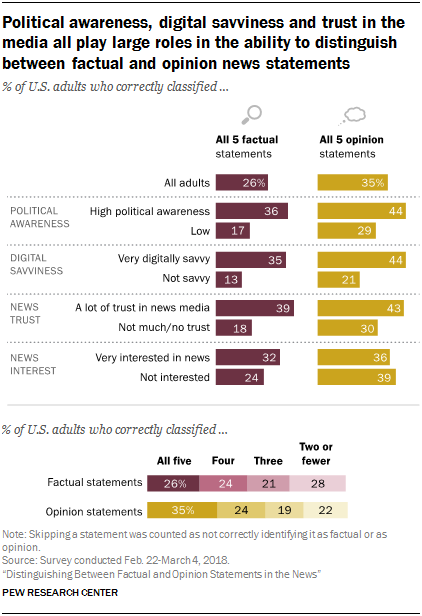A new study finds Americans struggle to identify factual statements, as opposed to opinion, in news articles. The findings address concerns over fake news.
Not surprisingly, the Pew Research study also found that people were more likely to think news statements are factual when the statements appeal to their side, even if the statements were opinions.
Factual statements, as defined by the researchers, is information that is capable of being proved or disproved by objective evidence.
Study participants were given five factual statements such as “spending on Social Security, Medicare and Medicaid make up the largest portion of the U.S. federal budget,” and five opinion statements such as “democracy is the greatest form of government.” They were asked to identify which ones were factual and which were opinions.
Only 26 percent were able to correctly identify all five factual statements. On opinions, about 35 percent were able to correctly identify all five statements. Roughly a quarter got most or all wrong in identifying facts and opinions, the research showed.
Conversely, 75 percent of American adults (if you extrapolate those 5,035 respondents to the total population) can be fooled by at least one out of every 10 headlines they come across. It is an indication of why “fake news” is so successful at promoting a particular viewpoint.
The study found that participants’ ability to classify statements as factual or opinion varied widely based on their political awareness, trust in the news media, and “digital savviness” or degree to which they are confident in using digital devices and the Internet.
“There is a striking difference in certain Americans in distinguishing what are factual statements and what are not, and that depends on one’s level of digital savviness, political savviness,” Amy Mitchell, director of journalism research at Pew Research Center, said in an interview.
 The study also found that when Americans call a statement “factual,” they overwhelmingly also think it is accurate. They tend to disagree with factual statements they incorrectly label as opinions, Pew said.
The study also found that when Americans call a statement “factual,” they overwhelmingly also think it is accurate. They tend to disagree with factual statements they incorrectly label as opinions, Pew said.
For example, one statement told participants “immigrants who are in the U.S. illegally have some rights under the Constitution.” Forty-three percent of identified Republicans called that statement factual while 65 percent of Democrats responded that it was true.
Another politically charged statement posed was “immigrants who are in the U.S. illegally are a very big problem for the country today.” Only 19 percent of Democrats said that the statement was factual while 50 percent of Republicans believed it to be correct.
The survey authors contend that these findings demonstrate the need for the public to learn how to sort through news with a more critical lens, but also states that “at this point the U.S. is not completely detached from what is factual and what is not.”
Meanwhile, another media study by the Knight Foundation found that Americans believe 62 percent of the news they see on television, read in newspapers and hear on the radio is biased. They also think 44 percent of it is inaccurate.
The results are even starker on social media. Respondents estimated that 80 percent of news on sites like Facebook and Twitter is biased—and 64 percent of it isn’t accurate.
You can take the Pew quiz for yourself here.

